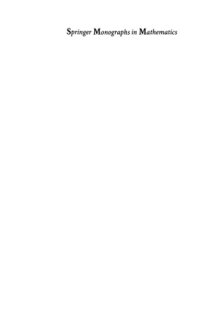
Ebook: Classical potential theory
Author: Armitage David H., Gardiner Stephen J
- Tags: Analysis, Analysis (Mathematics), Functions of a Complex Variable, Functions of complex variables, Mathematical analysis, Mathematics, Potential Theory, Potential theory (Mathematics), Electronic books
- Series: Springer monographs in mathematics
- Year: 2012
- Publisher: Springer London
- City: London
- Language: English
- djvu
1. Harmonic Functions -- 1.1. Laplace's equation -- 1.2. The mean value property -- 1.3. The Poisson integral for a ball -- 1.4. Harnack's inequalities -- 1.5. Families of harmonic functions: convergence properties -- 1.6. The Kelvin transform -- 1.7. Harmonic functions on half-spaces -- 1.8. Real-analyticity of harmonic functions -- 1.9. Exercises -- 2. Harmonic Polynomials -- 2.1. Spaces of homogeneous polynomials -- 2.2. Another inner product on a space of polynomials -- 2.3. Axially symmetric harmonic polynomials -- 2.4. Polynomial expansions of harmonic functions -- 2.5. Laurent expansions of harmonic functions -- 2.6. Harmonic approximation -- 2.7. Harmonic polynomials and classical polynomials -- 2.8. Exercises -- 3. Subharmonic Functions -- 3.1. Elementary properties -- 3.2. Criteria for subharmonicity -- 3.3. Approximation of subharmonic functions by smooth ones -- 3.4. Convexity and subharmonicity -- 3.5. Mean values and subharmonicity -- 3.6. Harmonic majorants -- 3.7. Families of subharmonic functions: convergence properties -- 3.8. Exercises -- 4. Potentials -- 4.1. Green functions -- 4.2. Potentials -- 4.3. The distributional Laplacian -- 4.4. The Riesz decomposition -- 4.5. Continuity and smoothness properties -- 4.6. Classical boundary limit theorems -- 4.7. Exercises -- 5. Polar Sets and Capacity -- 5.1. Polar sets -- 5.2. Removable singularity theorems -- 5.3. Reduced functions -- 5.4. The capacity of a compact set -- 5.5. Inner and outer capacity -- 5.6. Capacitable sets -- 5.7. The fundamental convergence theorem -- 5.8. Logarithmic capacity -- 5.9. Hausdorff measure and capacity -- 5.10. Exercises -- 6. The Dirichlet Problem -- 6.1. Introduction -- 6.2. Upper and lower PWB solutions -- 6.3. Further properties of PWB solutions -- 6.4. Harmonic measure -- 6.5. Negligible sets -- 6.6. Boundary behaviour -- 6.7. Behaviour near infinity -- 6.8. Regularity and the Green function -- 6.9. PWB solutions and reduced functions -- 6.10. Superharmonic extension -- 6.11. Exercises -- 7. The Fine Topology -- 7.1. Introduction -- 7.2. Thin sets -- 7.3. Thin sets and reduced functions -- 7.4. Fine limits -- 7.5. Thin set s and the Dirichlet problem -- 7.6. Thinness at infinity -- 7.7. Wiener' s criterion -- 7.8. Limit properties of superharmonic functions -- 7.9. Harmonic approximation -- 8. The Martin Boundary -- 8.1. The Martin kernel and Mart in boundary -- 8.2. Reduced functions and minimal harmonic functions -- 8.3. Reduction ?0s and ?1 -- 8.4. The Martin representation -- 8.5. The Martin boundary of a strip -- 8.6. The Martin kernel and the Kelvin transform -- 8.7. The boundary Harnack principle for Lipschitz domains -- 8.8. The Marti n boundary of a Lipschitz domain -- 9. Boundary Limits -- 9.1. Swept measures and the Dirichlet problem for the Martin compactification -- 9.2. Minimal thinness -- 9.3. Minimal fine limits -- 9.4. The Fatou-Naïm-Doob theorem -- 9.5. Minimal thinness in subdomains -- 9.6. Refinements of limit theorems -- 9.7. Minimal thinness in a half-space -- Historical Notes -- References -- Symbol Index.;From its origins in Newtonian physics, potential theory has developed into a major field of mathematical research. This book provides a comprehensive treatment of classical potential theory: it covers harmonic and subharmonic functions, maximum principles, polynomial expansions, Green functions, potentials and capacity, the Dirichlet problem and boundary integral representations. The first six chapters deal concretely with the basic theory, and include exercises. The final three chapters are more advanced and treat topological ideas specifically created for potential theory, such as the fine topology, the Martin boundary and minimal thinness. The presentation is largely self-contained and is accessible to graduate students, the only prerequisites being a reasonable grounding in analysis and several variables calculus, and a first course in measure theory. The book will prove an essential reference to all those with an interest in potential theory and its applications.
Download the book Classical potential theory for free or read online
Continue reading on any device:

Last viewed books
Related books
{related-news}
Comments (0)